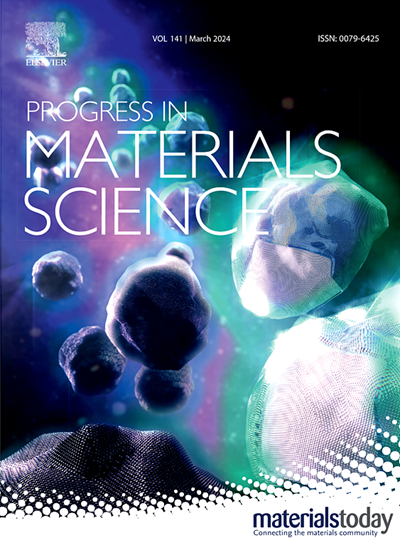接触电阻和界面工程:基于 2D-TMD 的高性能器件的进展
IF 33.6
1区 材料科学
Q1 MATERIALS SCIENCE, MULTIDISCIPLINARY
引用次数: 0
摘要
先进电子设备的发展取决于可持续的材料开发和开创性的研究突破。传统的半导体电子技术面临着材料厚度扩展和能效方面的限制。原子厚度极薄的二维过渡金属二掺杂物(TMDs)具有高电子迁移率、机械强度和可定制的带隙,是下一代纳米电子学和光电子学应用的理想候选材料。尽管具有这些优点,但费米级钉扎效应在金属-2D-TMD 接触处引入了不可控制的肖特基势垒,这对通过肖特基-莫特规则进行预测提出了挑战。这些势垒从根本上导致接触电阻升高和电流输送能力受限,阻碍了 2D-TMD 晶体管和集成电路性能的提升。在这篇综述中,我们简明扼要地概述了费米级针销效应机制和金属/二维-TMD 接口的特殊接触电阻行为。随后,将重点介绍克服二维-TMD 器件接触电阻的最新进展,包括界面相互作用和杂化、范德华(vdW)接触、预制金属转移和电荷转移掺杂。最后,讨论还将延伸到面临的挑战,并对未来的发展前景提出见解。本文章由计算机程序翻译,如有差异,请以英文原文为准。
Contact resistance and interfacial engineering: Advances in high-performance 2D-TMD based devices
The development of advanced electronic devices is contingent upon sustainable material development and pioneering research breakthroughs. Traditional semiconductor-based electronic technology faces constraints in material thickness scaling and energy efficiency. Atomically thin two-dimensional (2D) transition metal dichalcogenides (TMDs) have emerged as promising candidates for next-generation nanoelectronics and optoelectronic applications, boasting high electron mobility, mechanical strength, and a customizable band gap. Despite these merits, the Fermi level pinning effect introduces uncontrollable Schottky barriers at metal–2D-TMD contacts, challenging prediction through the Schottky-Mott rule. These barriers fundamentally lead to elevated contact resistance and limited current-delivery capability, impeding the enhancement of 2D-TMD transistor and integrated circuit properties. In this review, we succinctly outline the Fermi level pinning effect mechanism and peculiar contact resistance behavior at metal/2D-TMD interfaces. Subsequently, highlights on the recent advances in overcoming contact resistance in 2D-TMDs devices, encompassing interface interaction and hybridization, van der Waals (vdW) contacts, prefabricated metal transfer and charge-transfer doping will be addressed. Finally, the discussion extends to challenges and offers insights into future developmental prospects.
求助全文
通过发布文献求助,成功后即可免费获取论文全文。
去求助
来源期刊

Progress in Materials Science
工程技术-材料科学:综合
CiteScore
59.60
自引率
0.80%
发文量
101
审稿时长
11.4 months
期刊介绍:
Progress in Materials Science is a journal that publishes authoritative and critical reviews of recent advances in the science of materials. The focus of the journal is on the fundamental aspects of materials science, particularly those concerning microstructure and nanostructure and their relationship to properties. Emphasis is also placed on the thermodynamics, kinetics, mechanisms, and modeling of processes within materials, as well as the understanding of material properties in engineering and other applications.
The journal welcomes reviews from authors who are active leaders in the field of materials science and have a strong scientific track record. Materials of interest include metallic, ceramic, polymeric, biological, medical, and composite materials in all forms.
Manuscripts submitted to Progress in Materials Science are generally longer than those found in other research journals. While the focus is on invited reviews, interested authors may submit a proposal for consideration. Non-invited manuscripts are required to be preceded by the submission of a proposal. Authors publishing in Progress in Materials Science have the option to publish their research via subscription or open access. Open access publication requires the author or research funder to meet a publication fee (APC).
Abstracting and indexing services for Progress in Materials Science include Current Contents, Science Citation Index Expanded, Materials Science Citation Index, Chemical Abstracts, Engineering Index, INSPEC, and Scopus.
 求助内容:
求助内容: 应助结果提醒方式:
应助结果提醒方式:


